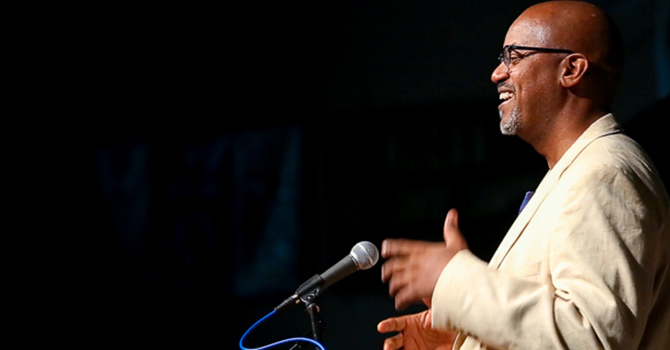When a leader must fire someone, give a bad performance review or have another kind of difficult conversation, it’s important to balance justice and mercy and advocacy with inquiry, said Jared Bleak, a former executive director of Duke Corporate Education.
One way to do that is to adopt an attitude of seeking information rather than advocating for a position, said Bleak, who served as a teacher, facilitator and coach at Duke Corporate Education from 2004 to 2014.
He has taught in the United States, Europe and Asia with clients including Siemens, Schering, PricewaterhouseCoopers, Progress Energy, Rio Tinto and Lafarge. Bleak received his bachelor’s degree from Brigham Young University and his master’s degree and doctorate from Harvard University. Before coming to Duke, he was at Harvard, where his research focused on organizational culture, leadership and governance.
Bleak recently spoke with Faith & Leadership about a four-step process for approaching difficult conversations. The following is an edited transcript.
Q: How do you recommend that pastoral leaders approach difficult conversations?
The essence of leadership is being able to have difficult conversations with difficult people at difficult times. The potential hazards are compounded [for pastoral leaders] because they are seen as someone who should give mercy but they’re also very much in a role of justice.
Most people think we’re good at these types of conversations with no preparation or forethought, and most of the time that leads us to make a bad situation worse.
Often we are in an advocacy mode; we have a point we want to make and are not listening to the other person. It’s important to have inquiring minds, to think of questions to open up this conversation and help me understand what’s happening in someone’s head.
Rather than listing all the things we’re going to say, balance advocacy with inquiry by preparing a list of questions we need to ask.
Q: Why would you need information or data from a person who, say, is having job performance issues? Or, in an extreme example, when a person is being fired?
Those situations are actually where you need data the most. As a leader, you want to get data from the place where you least want to hear it. Someone you are going to fire is going to point out issues that other people won’t because they don’t want to give bad news. It is important for a leader to get as much information as they can.
You know what the outcome is going to be, but you want to at least have some sort of conversation, especially in a church setting. This is a setting where empathy, mercy and love hold sway. As Christians, we need to be able to do what’s right but also do it in the right way.
Q: You generally work with business leaders. How does your strategy of dealing with difficult conversations apply to leaders in the church?
As a leader in the church, the expected outcome to the conversation never lessens our responsibility to seek to provide mercy, to get information, to learn and to help to the extent that we can and that is appropriate.
I don’t refer to it this way in a business setting, but my belief system is rooted in the example of Jesus as a communicator. He provided justice but he also was very merciful in his conversations.
In all of his leadership activities people were important, programs less so. Communication is all about connecting with that person across from you. It is about understanding their doubts, fears and issues, being able to deliver your message and come to some resolution that helps both to move forward.
Q: How can someone prepare for difficult conversations?
First off, consider the audience. Every good communicator needs to think about the attitudes or idiosyncrasies of the person they’re going to be speaking to. After that, you have to ask yourself a couple of questions: What do I most want to get from this conversation? What do I not want to have happen from this conversation? Thinking through the different sides helps you devise a simple strategy for the types of things you want to convey and the questions you want to ask.
I’m a big proponent of role playing. You’re sitting in your office and you call one of your peers and say, “I’m preparing for a conversation; let me play out how I think this is going to go and have you give me some advice. I’ll talk with you around how I’m going to start the conversation, or I’m going to deliver this line and I want you to react and see where it goes from there.”
This is about practice. Olympic athletes prepare and prepare and practice and practice and practice for that one moment. As professional leaders we never do.
One of the things that I teach is keeping in mind a simple structure for difficult or dangerous conversations. It’s a four-step process. The first step is to structure the conversation. You might say, “Jim, I want to speak with you for 30 minutes. I want to talk about a few things that are on my mind around your performance. I want to tell you things that I’ve noticed and ask a few questions; then I want to hear your perspective. After that we’re going to figure out the way forward.”
That structure is very easy. Set a structure. If we start by setting a structure for our conversation, we make our agenda open. We set things out and say, “This is where we are going to go.” That’s very helpful.
Q: You use the terms “difficult” and “dangerous” to describe these conversations. What do you mean by that word dangerous?
The term “dangerous conversations” is applicable where there is a risk that if we don’t do it well the conversation can be hazardous for us; there’s a greater likelihood that we won’t handle it well and it will get worse. That’s the dangerous element.
Those conversations could happen anywhere. They can happen in the workplace, in the church, between friends and between church leaders. They can happen in our families.
Q: So the first step is explicitly laying out the structure with the person.
The first step is to set structure. The second step is to get data. The third step is to give data -- those two steps can be interchanged -- and the fourth step is what I call “making sense.” It means to figure out where we’re going from here.
In a church setting it’s very appropriate to figure out the way forward in a collaborative fashion.
Q: If you know the person needs to be terminated, how can it be collaborative? Don’t you come to the conversation with an agenda?
If you’re terminating someone, making sense might be about some continuation of the relationship or helping them get on their feet in the shorter term or the arrangements for how the separation is going to work.
If it’s a disciplinary action, the making sense can be more involved. Getting information from that person is going to help create an environment for that person to succeed after the disciplining. You don’t want to discipline someone and leave them on their own without appropriate support. Making sense is a two-way process, and conversations are always two-way.
Q: Could you talk about your concept of the inner voice gap?
The inner voice gap is the gap between what we say and what’s going on inside our heads. It can be as small as asking, “How are you doing?” when in essence you’re asking how a project is going.
The bigger gap is the response from your employee or your co-worker when you ask, “How are you?” and they say, “Fine,” but in their head they’re saying, “I hate you.” Or when our inner voice starts blaming. We might verbalize that we know what we’re talking about, but in our heads we’re saying, “The person I’m talking to doesn’t have a clue.”
Should that gap always be closed completely? No. There are things that we shouldn’t say. Is communication more helpful when we operate with a more transparent agenda? Yes. Closing the gap is essential to communicating in an aligned and direct way with more effective outcomes.
The thing that makes this hard is that the gap highlights emotions, and that’s when conversations can potentially become quite dangerous.
Q: Why is it important to narrow the gap between what you are saying and what you are thinking?
We don’t necessarily articulate exactly what’s in our heads, but we use good communication skills to narrow that gap by listening and asking questions. By expressing ourselves clearly and thoughtfully, we can start to narrow that gap.
The four-step process that I explained earlier is a way to do that. The first step in setting a structure is to be explicit with what we want to do and oftentimes with what’s going on in our minds.
In terms of saying, “I know I’m right and therefore you’re wrong,” the solution to narrowing the gap is maybe saying, “I feel like I have a perspective that is valid.”
Then, instead of saying, “I know you’re wrong,” you narrow that gap by saying, “Help me understand your perspective, which I perceive as different from mine.” By saying, “You may be wrong, but I’m going to hear what that is all about,” we lessen that gap and get more aligned with the person with whom we’re trying to communicate.
A model that we use is called the ladder of inference, which is about how our brains process data and how we communicate that data. You can think of a ladder that is set down in a pool of water; the pool of water represents the data that we encounter around us. In that pool, we select data that we are familiar with, that align with our experiences, our notions of truth.
We start to move up this ladder with that data; we make judgments and decisions, gain perspective and shape that data by using our past experiences to help us reach conclusions. We then communicate our conclusions without ever communicating the data that we selected, the experiences or other things that helped us shape the data to get to a conclusion.
The technique here involves inquiry and advocacy. We ask the questions that will help us get to what is behind the conclusion that someone is stating.
If I know I’m right, what I should do is work someone down that ladder by saying, “I feel like I’m right here. Let me tell you about the experiences that I’ve had that tell me that this is the way this should be and then I want to tell you about some of the data that I’m looking at that have shaped my conclusion.”
Instead of coming with a conclusion and a position, we unravel and open up our thinking, which is going to narrow that gap.
We can ask the same thing of the other person. When they communicate a conclusion, we can ask them to say what experiences or data have led to that conclusion. It helps to narrow the gap, reveal agendas and align us more closely as communicators, as people having a conversation.
Q: Is it fair to say that what you’re talking about is making difficult conversations less about fixing blame and more about understanding each other?
Very much so. Not a lot of good comes out of fixing blame, because it is position-oriented. It puts us in a place where we’re advocating rather than inquiring; we’re saying, “It is your fault and I’m okay.” That increases distance between folks and raises animosity instead of getting to understanding.
One of Stephen Covey’s seven habits was “Seek first to understand and then to be understood.” What he was saying is: inquire, find out, don’t blame, understand, then you can seek to be understood. That balance is crucial. In interpersonal relations, that’s what it’s all about.
Q: Would you speak some more about the notion of the internal voice?
Oftentimes the internal voice can be our worst enemy, especially when we’re feeling vulnerable. That internal voice will cause us to lose confidence, to lose perspective and to lose the needed skills around listening, around asking good questions.
We become defensive. When we feel someone blaming us, the first thing we might say is, “No, you’re wrong.” But internally we might be saying, “Oh, maybe you’re right.” We start to question our self-worth; our confidence lags.
Managing that inner voice comes through listening more than thinking about what we are going to say next. Trying to listen, to question why we see this differently, to connect with the other person, can move us from advocacy to inquiry. Things become clearer when we make statements that end with a question rather than an exclamation point.
Q: Is this approach just about being nice, or is there some other reason to approach a difficult conversation in this manner?
There are a couple of reasons for this approach. As communicators, we don’t have to be hard all the time. We have a message to deliver and oftentimes that’s a message that’s set and will not waver, yet we’re still talking with another person who has feelings, perspective, insight, and it’s helpful for us to hear those.
Whether asking questions is being nice or being strategic, there are important benefits to gain by using inquiry, by getting data, by making sense with others.
In the setting of the church, our exemplar Jesus Christ asked many questions, even when he was being called on the carpet or accused. Often he asked questions and then taught lessons, gave messages, caused greater thinking to occur and allowed communication to happen in powerful ways.
Q: Do you have any advice about communication skills that keep you from getting into a tough spot to begin with?
Often in a leadership role, problems are brought to us with no input into previous conversations where we might have mitigated the problem.
Being transparent and honest, to the extent possible, by telling people the whole story will help us avoid difficult conversations built around misunderstanding or unaligned expectations. Being transparent as leaders, communicating as best we can through different modalities -- talking directly with people, writing clearly in e-mail or newsletters -- helps avoid these difficult or dangerous conversations.
We’ll never fully avoid these types of conversations. Even in the most loving relationships, we get in situations where we have to give and receive messages that are hard. We can try to lessen the impact, but as we improve our skills in dealing with those situations, we’ll be better off over the long haul.







